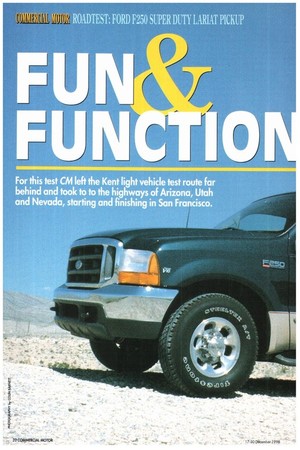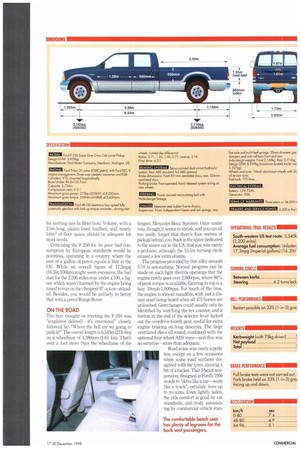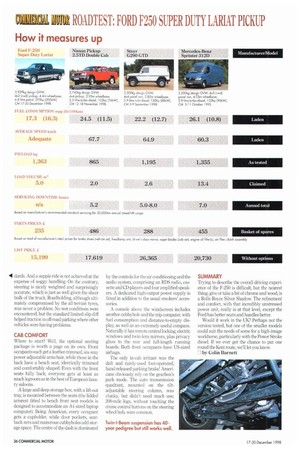For this test CM left the Kent light vehicle test route far
Page 34

Page 35

Page 36

Page 37

Page 38

If you've noticed an error in this article please click here to report it so we can fix it.
behind and took to to the highways of Arizona, Utah and Nevada, starting and finishing in San Francisco.
readers can now have a taste of the best-selling vehicle on the other side of the Atlantic. The Ford F-Series pickup sells around 860,000 units per year into the US pickup market of two million. The best-selling ac the locally built Toyota Camry, manages about 370,000 units. The current popularity of pickups can be traced to 975, when Federal legislation attempted to promote more economical cars. The rules created less stringent requirements for some types of vehicle, resulting in an explosion of popularity for 4x4s, TAM and pickups.
They worked to the extent of killing o a handful of the gas-guzzling dinosa the overall fuel saving was considera than intended. However, their days may numbered as the Californian governm decided that from 2004 pickup truck meet the same emission standards as The pickup market has now devek the point where they are driven not tradesmen and country dwellers, but as much at home in urban areas where t regarded as essential lifestyle accessori result, development of pickups has
41 unimagined levels, and the F-250 tested is a prime illustration of the state of the art.
PRODUCT PROFILE The current Ford F-Series traces its ancestry directly to the Ford F-1 of 1948. By the time of the F-100's launch in 1953. Ford had built 17m pickups since the Model T of 1925. Highlights of this illustrious career include the introduction of a 4x4 in 1959, and the "Twin-I-Beam" independent front suspension in 1965. From the beginning, the F-Series has had option packs to cater for every taste and need. When Money magazine recently listed the 99 things that America makes best, the only motor vehicle on the list was the Ford F-Series.
Today's F-Series includes a model for all reasons, beginning with the F-150, comparable in size to the Japanese pickups the UK is used to. The Super Duty range runs from the F-250 at 3.9 tonnes GVW right up to the F-550 at 8.5 tonnes. Wheelbases go from 148m to 5.1m, with 4x2, 4x4 and twin-rear-wheel versions. Cabs can be single, extended or double, in pickup or chassis-cab form.
Two petrol engines and one diesel are available. The Triton petrol engine comes in a choice of 5.4-litre V8 or 6.8-litre V10, while the Power Stroke is a 7.3-litre V8 charge-cooled Navistar turbo-diesel, producing a staggering 678Nm (5001b10 of torque at 1,600rpm.
The V10 Triton petrol engine has an iron block and aluminium heads with a single chain-driven OHC per bank. The inherent imbalance of the layout is countered with a balance shaft. Fuel and ignition are provided by the Ford EEC-V system, which includes a fail-safe overheating shut-down system to reduce temperatures in the event of coolant loss. Individual direct-ignition coils are mounted above the platinum spark plugs (which have a life of 160,000km).
Transmissions are five and six-speed manuals and a four-speed electronic automatic. 4x4s have a two-speed transfer box, while all transmissions have the facility to include a power take-off. PTOs on automatics is a new feature for Ford, apparently in response to a shortage of drivers able to operate manual transmissions!
Even the smallest F-Series Super Duty is built on a steel ladder-frame chassis that wouldn't look out of place on a European 7.5. tonner. Rear suspension is conventional live axle and cart spring fare, although, again, the axle looks over-specified. 4x4 and larger 4x2 versions have a similar configuration at the front, but the F-250/350 4x2s have a more original layout.
Ford's "Twin-I-Beam", introduced in 1965, has been a hallmark of the F-Series ever since. Each front wheel is attached to a long forgedsteel I-section beam which is pivoted from the opposite chassis rail, a steel coil providing the springing. Each beam is mounted at an angle to allow clearance for its opposite number, and is located by a longitudinal radius rod.
As well as the basic transport function of the F-Series, it is frequently used as the basis for snow plough, ambulance and camper-van conversions. A package is also available to mount a swan-neck fifth-wheel coupling for mini-artic horse boxes, racing car transporters and the like. The largest models have GCWs up to 1L6 tonnes.
The version tested is the F-250 Super Duty Crew Cab Lariat 4x2 SRW LWB Triton V10 Pickup. It was also supplied with the Preferred Equipment Package, plus a modest selection of other options just to make sure it got attention!
PRODUCTIVITY Unfortunately it wasn't possible for this test to use our usual route (in Kent) or to load our usual test weights. But by way of some compensation, CM was able to complete a longer than usual 2,200-mile circular route based on San Francisco, visiting Arizona, Utah and Nevada ... naturally with a similar mix of town centre, country roads and motorway to our south of England run. The vehicle had just 250kg of payload, including the driver.
The possible payload of 1,363kg might seem modest for its size, but if weight were an issue then a more utilitarian version could be specified—the options on CM 's test version don't come
for nothing (see In Brief box). Volume, with a 2.5m-long, plastic-lined loadbed, and nearly 5.0m2 of floor space, should be adequate for most needs.
Criticising the F-250 for its poor fuel consumption by European standards would be pointless, operating in a country where the cost of a gallon of petrol equals a litre in the UK. While an overall figure of 17.3mpg (16.31it/100km) might seem excessive, the fuel cost for the 2,200 miles was under £100, a figure which wasn't harmed by the engine being tuned to run on the cheapest 87 octane unleaded. Besides, you would be unlikely to better that with a petrol Range Rover.
ON THE ROAD The first thought on meeting the F-250 was "(expletive deleted)—it's enormous!" closely followed by "Where the hell are we going to park it?" The overall length is 6,543m (21ft 6in) on a wheelbase of 4,380mm (14ft 4in). That's over a foot more than the wheelbase of the longest Mercedes-Benz Sprinter. Once under way, though, it seems to shrink, and you can all too easily forget that there's four metres of pickup behind you. Such is the space dedicated to the motor car in the US, that size was rarely a problem, although the 15.5m turning circle caused a few extra shunts.
The progress provided by that silky-smooth V10 is astonishing, Normal progress can be made on such light throttle openings that the engine rarely goes over 2,000rpm, where 90% of peak torque is available. Gearing in top is a lazy 30mph/1,000rpm. For much of the time, the engine is almost inaudible, with just a distant snarl being heard when all 475 horses are unleashed. Gearchanges could usually only be identified by watching the rev counter, and a button in the end of the selector lever locked out the overdrive fourth gear, useful for extra engine braking on long descents. The large ventilated discs all round, combined with the optional four-wheel ABS were—and this was no surprise—more than adequate.
Road noise was rarely a problem, except on a few occasions when some road surfaces disagreed with the tyres, causing a hit of a racket. That I-beam suspension, designed in Ford's 1956 words to "drive like a cur—work like a truck", certainly lives up to its aims. Even lightly laden, the ride comfort is good by car standards, and truly astonishing by commercial vehicle stan • dards. And a supple ride is not achieved at the expense of soggy handling. On the contrary, steering is nicely weighted and surprisingly accurate, which is just as well given the sheer bulk of the truck. Roadholding, although ultimately compromised by the all-terrain tyres, was never a problem. No wet conditions were encountered, but the standard limited slip diff helped traction in off-road parking where other vehicles were having problems.
CAB COMFORT
Where to start? Well, the optional seating package is worth a page on its own. Front occupants each get a leather-trimmed, six-way power adjustable armchair, while those in the back have a bench seat, identically trimmed and comfortably shaped. Even with the front seats fully back, everyone gets at least as much legroom as in the best of European luxury saloons.
A large and deep storage box, with a lift-out tray, is mounted between the seats (the lidded armrest fitted to bench front seat models is designed to accommodate an A4 sized laptop computer). Being American, every occupant gets a cupholder, while door pockets, seatback nets and numerous cubbyholes add storage space. The centre of the dash is dominated by the controls for the air conditioning and the audio system, comprising an RDS radio, cassette and CD players and four amplified speakers. A dedicated high-output power supply is fitted in addition to the usual smokers' accessories.
A console above the windscreen includes another cubbyhole and the trip computer, with fuel consumption and distance-to-empty display. as well as an extremely useful compass. Naturally it has remote central locking, electric windows and twin-lens mirrors, plus privacy glass to the rear and full-length running boards. Both front occupants have US-sized airbags,
The only in-cab irritant was the daft and rarely-used foot-operated, hand-released parking brake! Americans obviously rely on the gearbox's park mode. The auto n-ansmission quadrant, mounted on the tiltadjustable steering column, was clunky, but didn't need much use; 200-mile legs, without touching the cruise control buttons on the steering wheel hub, were common. SUMMARY
Trying to describe the overall driving experience of the F-250 is difficult, but the nearest thing, give or take a bit of chrome and wood, is a Rolls Royce Silver Shadow. The refinement and comfort, with that incredibly unstressed power unit, really is at that level, except the Ford has better seats and handles better.
Would it work in the UK? Perhaps not the version tested, but one of the smaller models could suit the needs of some for a high-image workhorse, particularly with the Power Stroke diesel. If we ever get the chance to put one round the Kent route, we'll let you know.
'l by Colin Barnett Price as k (ex-US tax): £19,382, includes £15,199 for basic vehicl Preferred Equipment Package, £1,693; V1O engine, E202; automatic transmission, £584; four-wheel ABS, £301; limited slip differential, £18 Engin( 6.8 litres, 205kW (275hp) V10 petrol. GVVV: 3,929kg. GCW: 3,929kg. Payload: 1,363kg. Fuel consumption: (unladen): 17.3mpg (16.314/100km). MIMI Ford F-250 Super Doty Crew Cab Lariat Pickup Design GVW: 3,929kg.
Manufacturer: Ford Motor Company, Dearborn, Michigan, US.
Mil Ford Triton 20-valve SOHC petrol, with Ford EEC-V engine management. Three-way catalytic converter and EGR. Cylinders: VI 0, mounted longitudinally.
Bore/stroke: 90.2x105 7mm Capacity: 6,754cc Compression ratio: 9.0:1 Maximum gross power: 275hp (205kW) at 4,25Orpm. Maximum gross torque 556Nrn (4101bh) at 2,65Orpre
Ford 48103 electronic (our-speed fulfy automottc gearbox with lock-up torque converter , driving rear
TRANSMISSION wheels Limited slip differential.
Ratios: 2.71, 1.54, 1.00, 0 71; reverse, 2.18. Final drive: 4.3:1.
ranZERMIEM Servo-assisted dual-circuit hydraulic system Rea, 435 standard, full ABS optional. Brake dimensions: Front 331 rem ventilated discs, rear, 326rum ventilated discs.
Parking broke: Foot operated, hand released system acting on rear wheelt.
IMEIM Power assisted recirculating ball with Ha Itelberger linkage.
SEM Separate steel ladder-frame chassis. Suspension Front, Independent I-beam and coil springs; rear live axle and multi-leaf springs. 35mm diameter gas dampers and anti-roll bars front and rear.
Axle design weights: Front 2,265kg. Rear 2,716kg. Design GTW 8,929kg (maximum braked trailer we 5,357kg). Wheels and tyres: 6inch aluminium wheels with 2t all terrain tyres.
Fuel tank: 173 litres.
E IOWA' 5 Y STE mS.
Battery. I 2V, 72Ah. Generator: 95A.
TERMS Of WARRANTY: Three years or 36,000 rr
DEALERS AND SERVICE POINTS. 4200, in the I OPERATIONAL TRIAL RESULTS
South-western US test route: 3,5401( 12,200 miles.
Average fuel consumption: Unladen 17.3mpg (Imperial gallons{116,31it/
TURNING CIRCLE
Between kerbs
Steering 4.2 turns lock
HILL PERFORMANCE Restart possible on 33% (1-in-3) grac
WEIGHTS
Kerkiweight (with 75kg driver) Net payload
Total
BRAKE PERFORMANCE
Full brake tests were not carried out. Park brake held on 33% (1-in-3) gra. facing up and down.
ACCELERATION
km/II sec 0-80 7.4
48-80 64-96 4.9 6.1
How it measures up
Ford F-250 Super Duty Lariat
3929k9 design GVW, 4x2 (rwrI) pickup, 4 4m wheelbase, 6 8 litre petrol, 275hp (205kW) CM 17-30 December 1998 FUEL COW 'NurrioN mpg tit/1 00km
17.3 (16.3)
AVERAGE SPEED km/h
Adequate
PAYLOAD kg
1,363
LOAD VOI NIE m
5.0
SERVICING DOWNTIME hours
nia
Based on rnanufodurees recommended standard servicing for 50,000km annual mixed UK usage
PARTS PRICES
235
Based on total of manufacturer's retail prices for brake shoes ivehicle set), headlamp unit, driver's door mirror, wiper blades (cab seri, engine oil (ilter(s), vi,Ciljtr+
LIST PRICE
15,199
Nissan Pickup 2.5TD Double Cab
2,740k9 design GAM,
4x4 pickup, 2.95m wheelbase, 2.5-litre turbo-diesel, 102hp 176kW), CM 12-18 November 1998.
24.5 (11.5) 67.7 865 2.0 5.2 486 17.619
Steyr G290 GTD
3,500kg design GVW,
4x4 panel von, 2.85m wheelbase, 2 9-litre turb-diesel, 120hp (1:18kW), CM 3-9 September 1998
22.2 (12.7) 64.9 1,195 2.6
5.0-8.0
288
26,365 Mercedes-Benz Sprinter 312D
3,500k9 design MAN', 4x2 (rwc1) panel von, 4.03m wheelbase, 2.9-litre turbo-diesel, 122hp (90kW), CM 5-11 October 1995_
26.1 (10.8) 60.3 1,355 13.4 7.0 455
20,730












































































































































